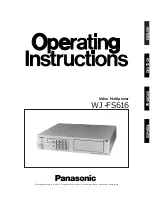
MULTITEST M72 - M73 - M74 - M75
EN - 4
2. GENERAL DESCRIPTION
Dear Customer, the instrument you have purchased, whether used according to the
instructions given in this manual, will grant you accurate and reliable measurements.
Thanks to a development of newest conception assuring double insulation and overvoltage
category III you will enjoy the highest safety. This manual refers to the entire range of
MULTITEST family including M72, M73, M74 e M75 models. Except where otherwise
expressly indicated, this manual refers to all these models.
2.1. WORKING
)
V
Hz
: DC and AC TRMS voltage measurement, frequency measurement.
)
A
Hz
: DC and AC TRMS current measurement, frequency measurement by means
of current transducer (clamp) with max. full scale of 1V.
)
Ω
:
measurement of resistance / continuity with sound signal
)
:
phase sequence detection at one or two terminals
)
LAN
:
wire mapping for cables UTP, STP, FTP (SCTP), SFTP, SSTP in any
category (Cat. 3, 5, 5E, 6, etc.) with connector RJ45 capable of measuring
through connection to remote unit (M75 only).
)
Ω
0.2A
: continuity test on earth, protective and potential equalising conductors with a test
current higher than 200mA and open voltage ranging from 4V to 24V (M72, M74,
M75 only)
)
M
Ω
:
insulation resistance measurement with test DC voltage of 250, 500VDC (M72,
M74, M75 only).
)
RCD
:
measurement on RCDs type AC (
)(M73, M74, M75 only)
)
Ra
measurement of total earth resistance (M73, M74, M75 only)
)
AUTO
performance of measurements in
Ra
,
RCD
and
M
Ω
with automatic sequence (
M74, M75 only)
2.2.
TRMS VALUE AND MEAN VALUE - DEFINITIONS
Safety testers for alternate quantities are divided into two categories:
•
MEAN VALUE instruments: instruments measuring only the value of the wave at the
fundamental frequency (50 or 60Hz);
•
True Root Mean Square (TRMS) instruments: instruments measuring the true root
mean square value of the quantity under test.
Mean value instruments provide only the value of the fundamental wave while TRMS
instruments provide the value of the entire wave, including harmonics (within the passband
of the instrument). Accordingly, the measured values are identical only if the wave is
purely sinusoidal.
2.3.
TRUE ROOT MEAN SQUARE VALUE AND CREST FACTOR - DEFINITIONS
The current effective value is defined as follows: “In an interval of time equivalent to a
period, an alternate current with effective value having an intensity of 1A, by passing on a
resistor, disperses the same energy which would be dispersed in the same period of time
by a direct current having an intensity of 1A”. From this definition we get the numerical
expression: G=
∫
+
T
t
t
dt
t
g
T
0
0
)
(
1
2
The effective value is indicated as RMS (
root mean square
).
The crest factor is defined as the ratio between the peak value of a signal and its effective
value: CF (G)=
RMS
p
G
G
. This value varies according to the waveform of the signal, for a purely
sinusoidal wave it’s worth
2
=1.41. In presence of distortions, the higher the wave
distortion is, the higher the crest factor values get.






































